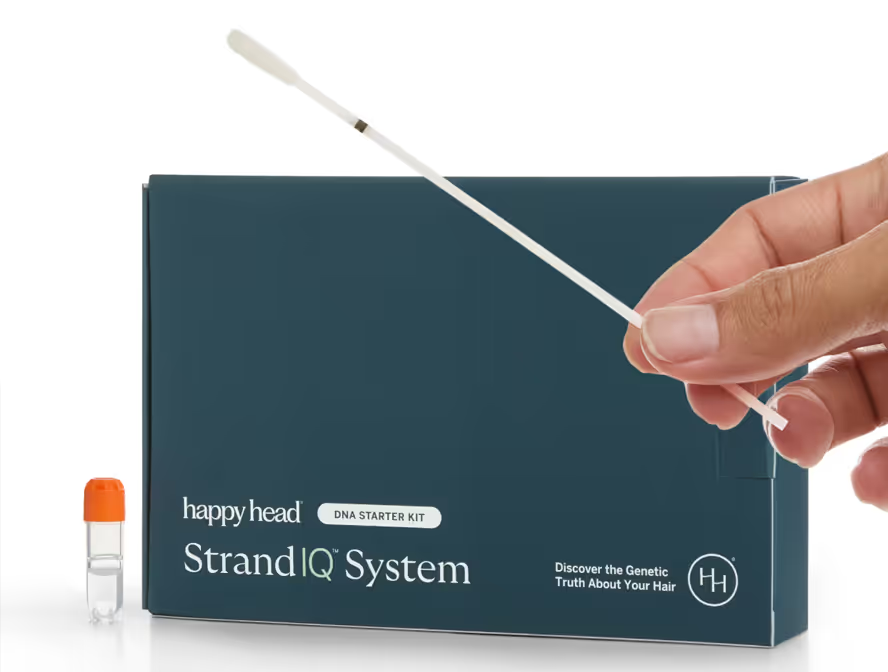Noticing patchy bald spots that seem to appear overnight? You’re not imagining things—and you’re not alone. Nearly seven million people in the United States have alopecia areata. It's the second-most common form of hair loss, behind female- and male pattern baldness.
It’s a common autoimmune condition, but it can be emotionally difficult to experience. The good news? There are smart, science-backed ways to manage it—and in many cases, help hair grow back.
Let’s explain alopecia areata: what it is, why it happens, and what your options are—sorted by your Happy Head StrandIQ™ analysis-identified risk level so you can choose a remedy that feels right for you.
First, What Is Alopecia Areata?
Alopecia areata is an autoimmune disorder, meaning your immune system targets and attacks your body’s hair follicles. This attack causes inflammation, interrupting your hair’s growth cycle, leading to sudden, round or oval bald spots, often on the scalp—though hair anywhere on the body can be affected.
Here’s what we know:
- It’s not caused by stress alone (though stress can make it worse).
- Genetics play a major role—about 40% of people under 30 with alopecia areata have a family history.
- It can affect anyone but may be more noticeable in those with darker or thicker hair.
- Unlike male-pattern baldness or general thinning, alopecia areata tends to cause patchy, abrupt loss.
The condition isn’t contagious, and it doesn’t mean something else is wrong with you. But it does mean your immune system needs a little extra support.
The Role of DNA: Why Genetics Matter in Alopecia Areata
Your DNA doesn’t just determine your eye color or height—it also plays a significant role in how likely you are to develop alopecia areata. In fact, genetics are one of the strongest predictors of this autoimmune condition. Research shows that around 40% of people diagnosed with alopecia areata before age 30 have a family history of the condition.
Scientists have identified several genes that increase susceptibility to alopecia areata, especially those involved in immune system regulation. Key among them is the HLA (human leukocyte antigen) gene family, which helps the immune system recognize your own body’s tissues. In people with alopecia areata, certain variations in these genes may confuse the immune system, causing it to mistakenly attack healthy hair follicles.
Other genes—like IL2RA and CTLA4—are involved in T-cell activation and immune response control, further supporting the idea that alopecia areata is largely a genetic autoimmune condition. These findings don’t mean that your genes alone will cause hair loss, but they do help explain why some people are more vulnerable than others when exposed to triggers like stress, inflammation, or environmental changes.
That’s why StrandIQ, which analyzes your unique biology and risk profile, may make a big difference in the types of treatments you choose. By understanding your genetic predisposition, we can better tailor personalized hair care routines (which may include treatments) and even take preventative steps to support scalp health before hair loss worsens.
Alopecia Areata Treatment Options, Sorted by Risk Level
There’s no one-size-fits-all treatment for alopecia areata, but there are plenty of options. At Happy Head, we believe in smart, layered care: start with the basics, then build up if you need more help.
Low-Risk Options: Start Here
If your StrandIQ report has identified you as being at low risk for alopecia areata, you might be able to manage symptoms with some simple lifestyle changes. These strategies are gentle, affordable, and easy to stick with:
- Get your nutrition in check
Hair follicles are high-maintenance and need steady nutrients to thrive. If you’re skipping meals or on a restrictive diet, your hair might feel it first. Instead, prioritize eating a well-balanced diet and avoid ultra-processed foods, fried foods, and food and drinks with added sugars. - Dial down stress
Stress doesn’t cause alopecia areata directly, but it can aggravate it. Try stress-reducing practices including mindfulness, breathing exercises, or even taking a walk outdoors. These simple lifestyle changes can help to reduce systemic inflammation. - Be gentle with your hair
Over-washing, tight hairstyles, or frequent dye jobs can all irritate the scalp and stress hair follicles that are already under attack. Use a soft-bristled brush, skip harsh treatments, and go easy on styling tools.
Medium-Risk Options: For More Persistent Cases
If your StrandIQ report identified you as being at medium risk for alopecia areata, or if low risk measures have not been effective, it might be time to level up. These options involve a bit more commitment but are still safe and commonly used.
- Topical or injected corticosteroids
Corticosteroids can help to reduce inflammation around the follicles, giving hair a chance to regrow. They’re one of the most common treatments for alopecia areata and can work well for small to moderate areas. - Hormone or immune-modulating therapies
In some cases, estrogen therapy or other medications that influence immune function might be recommended—especially if your hair loss has a hormonal component. - Lifestyle and scalp care combination
Keep up your balanced diet, use gentle hair products, and limit scalp trauma. Pairing these with topical medications can speed up regrowth and reduce future flare-ups.
High-Risk/Clinical Treatments: When You Need the Big Guns
If alopecia areata is widespread, recurring, or deeply affecting your confidence, you don’t have to white-knuckle it. Clinical treatments are available—and they can be very effective when guided by a dermatologist.
- Prescription-strength corticosteroids
These are often injected directly into the scalp, and they can help rapidly reduce inflammation in targeted areas. - JAK inhibitors and immunologic agents
Newer treatments like tofacitinib or ruxolitinib (JAK inhibitors) work by targeting the immune response behind alopecia areata. These are prescription-only and should be carefully monitored, but they’ve shown strong promise in clinical trials. - Protective styles and scalp care
Choose loose hairstyles that reduce tension. Avoid braids, buns, or weaves that tug at your roots. Keep your scalp calm with moisturizing serums and gentle products. - Work with a dermatologist
This is key. If you’re dealing with widespread hair loss, or if patches keep coming back, a dermatologist can help tailor a personalized hair care routine that works for your needs and goals.
A Path Forward From Alopecia Areata
Alopecia areata can feel frustrating—and sometimes isolating—but you’re not stuck with it. Many people experience regrowth, especially with early, consistent care. Others learn to manage flare-ups and keep their scalp healthier long-term.
At Happy Head, we believe in personalized care. Whether you’re just noticing your first bald spot or you’ve been dealing with alopecia for a while, there’s a path forward. From everyday hair health habits to powerful dermatologist-prescribed options , the right plan can help you regain control—and feel like yourself again.
References
StrandIQ SNP Marker Count: 31
StrandIQ Genes for Trait:
ACOXL, AP4B1-AS1, ATXN2, CCDC88B, CIT, CLEC16A, CTLA4, ERBB3, FPR1, FPR2, GSE1, IFNG-AS1, IL13, IL2RA, IRF4, LINC01882, LPP, MAGI3, MIR4435-2HG, MRLN, MTCO3P1, PFKFB3, PLXNC1, PTCSC2, PTPN22, RAET1M, SLC16A9, SYT14, TAFA2, TH2LCRR, TNFRSF1A
References:
Chen, Y., et al. (2023). Genetic prediction of male pattern baldness based on large independent datasets. European Journal of Human Genetics, 31(3), 321–328. PMID: 36336714.
Eriksson, A.L., et al. (2009). Genetic variations in sex steroid-related genes as predictors of serum estrogen levels in men. Journal of Clinical Endocrinology & Metabolism, 94(3), 1033–1041. PMID: 19116238.
Hagenaars, S.P., et al. (2017). Genetic prediction of male pattern baldness. PLoS Genetics, 13(2), e1006594. PMID: 28196072.
Heilmann-Heimbach, S., et al. (2017). Meta-analysis identifies novel risk loci and yields systematic insights into the biology of male-pattern baldness. Nature Communications, 8, 14694. PMID: 28272467.
Kanda, S., et al. (2015). Effects of functional genetic polymorphisms in the CYP19A1 gene on prostate cancer risk and survival. International Journal of Cancer, 136(1), 74–82. PMID: 24803183.
Liu, F., et al. (2016). Prediction of male-pattern baldness from genotypes. European Journal of Human Genetics, 24(6), 895–902. PMID: 26508577.
Marcińska, M., et al. (2015). Evaluation of DNA variants associated with androgenetic alopecia and their potential to predict male pattern baldness. PLoS One, 10(5), e0127852. PMID: 26001114.
Pirastu, N., et al. (2017). GWAS for male-pattern baldness identifies 71 susceptibility loci explaining 38% of the risk. Nature Communications, 8(1), 1584. PMID: 29146897.
Yap, C.X., et al. (2018). Dissection of genetic variation and evidence for pleiotropy in male pattern baldness. Nature Communications, 9(1), 5407. PMID: 30573740.
This content, including StrandIQ™ DNA analysis reports and any Happy Head products and/or services referenced therein, is for informational and cosmetic purposes only. It is not intended to diagnose, treat, cure, or prevent any disease. This content does not constitute medical advice and should not be used to make healthcare decisions. References to prescription treatments are educational in nature. Always consult a licensed healthcare professional for any medical concerns or treatment decisions.








.avif)

